
KickBeat
Developer: Zen Studios
Publisher: Zen Studios
Platforms: PS3 (Reviewed), PS Vita
Release Date: US: September 3rd/Europe: September 11th
Price: $9.99 (20% discount first week special for PS Plus Subscribers, PS3/PS Vita CrossBuy Entitled) – Download on PSN
Overview
KickBeat is a rhythm game inspired by the likes of Guitar Hero and Dance Dance Revolution where you press buttons to the beat to improve your score and multiplier. While in that regards the games are very similar, KickBeat mixes it up by applying a kung fu theme to the action. This isn’t just something that is applied to the background like a music video though, as the martial arts has woven it’s way into many aspects of the game. You won’t just be pressing buttons in correspondance to arrows passing a checkpoint on the screen, rather the buttons you need to press correspond to the position and type of your enemies which move and attack to the beat.
Story
The story centers around the musical Kung Fu Masters Lee and Mei as they track down the evil Mr. Halisi who has stolen the mystical Sphere of Music, an orb that contains every song ever created. You manage to save 18 songs (which cleverly matches up to the amount of songs in the game) and now have to track down the music thief to save the world’s music. The story is light hearted and full of classic Kung Fu movie tropes as well as a few jokes here and there (such as Master Fu using his cell phone instead of the Ethereal Channel to call Lee because his phone had signal). The story won’t win any awards but it serves as a nice explanation as to why you travel to different locations across the world as well as providing some nice backstory on the likable characters. Once you complete the game as Lee you can then complete the game as Mei. The songs and order you play them in remain the same, but Mei’s story continues where Lee’s left off and focuses more on her backstory and relationship with her grandfather Master Fu.
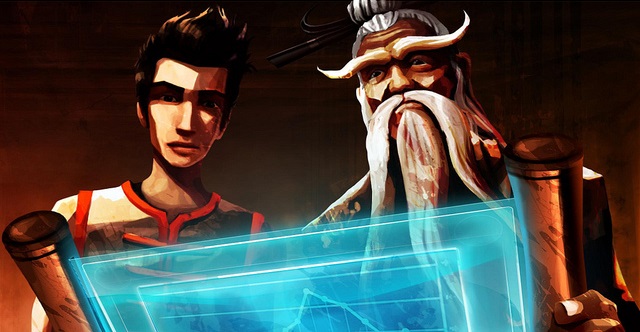
The story is told through cutscenes that feature still water colour paintings that are hand animated. Alot of love and attention has been applied to these scenes and it shines through. However sometimes it seems that one too many frames were created and with the crossfades that are used to transition between each picture sometimes it doesn’t look quite right. For example in one scene Lee is sweeping outside the temple. What could of been done with two frames with Lee sweeping left and then right is instead done with three and the crossfades make it blurry and hard to appreciate the scenes. This doesn’t happen too often but is noticable when it does. The scenes are all fully voiced and the voices all fit the characters perfectly. The acting is up to standard for the most part but does feature a few moments where the delivery feels a bit off.
Gameplay
KickBeat doesn’t redefine the rhythm genre in terms of its core gameplay. You press the correct buttons to match the visual cues to the beat to score points. Miss your cue too many times and you will lose health and eventually fail the song. Keep hitting the beat consistently and your score and multiplier will increase. Where KickBeat differs is the way it presents the musical cues and other information to the player. The character your playing as stands in the middle of the stage surrounded by enemies who represent which face button to press (you can also use the D-pad). They will circle around you until they reach their position and when they attack, that is your cue to counter by pressing the correct button at the correct time. With each button press you will be given a ranking such as perfect or great which lets you know how good your timing was. If you miss all together you will get hit and lose health which will lead to you failing the song and having to restart if your health drops to zero. Successful hits also build up your chi, which is used just like star power in Guitar Hero to double your multiplier. Using Chi at the correct times is the key to getting a huge score.
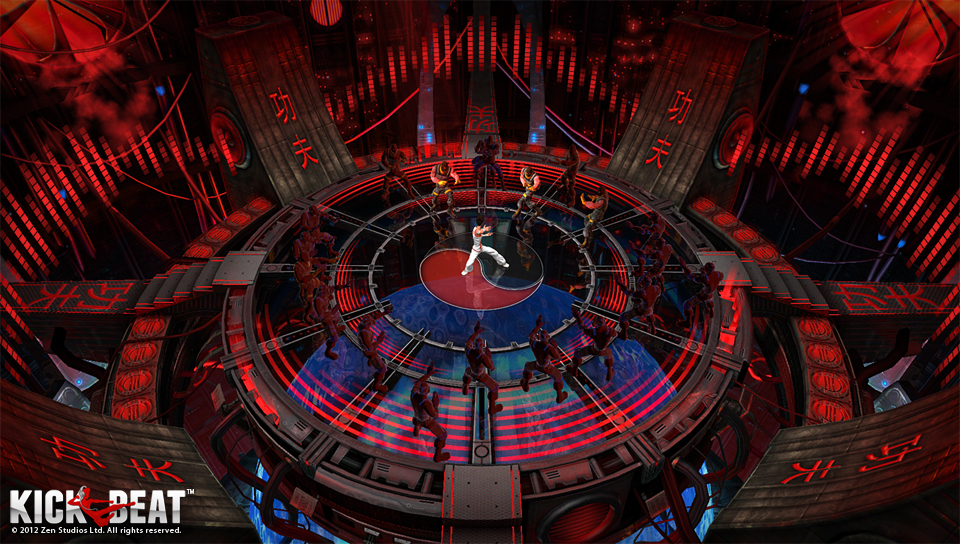
Enemies come in three flavours. Yellow ones require a single button press to the beat, blue enemies attack on half beats and normally come in a pair or successive groups, and red enemies attack together on the same beat requiring you to press two face buttons at once (three on expert difficulty). Some enemies are also chained together by energy and require a hold and release mechanic to be used against them. Enemies can also feature powerups, which are obtained by tapping the face button again after defeating the enemy. Powerups range from things that help you in game like a shockwave that kills surrounding enemies and gives you some breathing room, to multiplier and score bonuses. These differing elements bring variety to the gameplay and ensure the game does not become monotonous.
All this sounds fairly simple and standard on paper but in execution the innovative interface in combination with the backgrounds and lighting effects sometimes makes it very difficult to see what the next visual is. I don’t mind being punished in a music game for being off beat and mis-timing a button click, however it is very frustrating to lose your multiplier and take a hit because you didn’t see an enemy or were unsure which enemy was going to attack first. It’s easy to see why games like Dance Dance Revolution and Guitar Hero have stuck to that simple interface of notes flowing down the screen to a persistent checkpoint as they offer the player enough time to see what’s coming next and the consistent position means you always know where to look for your next note. On the normal difficulty, the game does offer more standard visual cues in the form of glowing markers that match the face buttons, however the assistance of those markers are removed in harder difficulties and can’t be turned on via an in game option.
It’s very frustrating because when you do build up a combo and really start to feel the beat the game is alot of fun and you can get really into it. Smashing enemies to the high energy tracks in the game is really satisfying and pumps you up, but that feeling is too often interrupted by my character taking a hit due to the poor visibility of a visual cue.
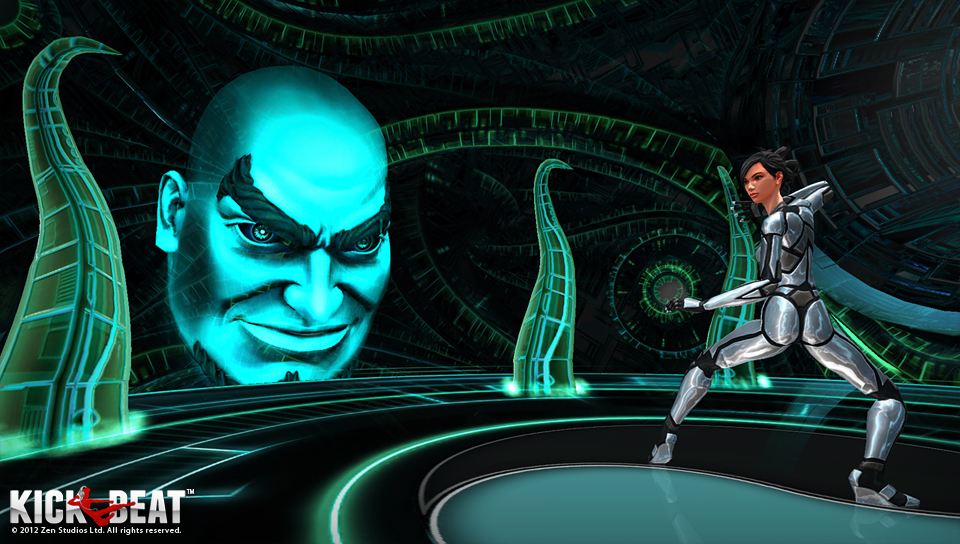
KickBeat features a few boss fights throughout the story but outside of a few unique animations and visual cues (such as missiles instead of enemies) the aim of the game is exactly the same. The last boss fight is annoying at first as the enemy has these purple spikes on top of its virtual tentacles that you have to double tap like powerups to destroy or they will hurt you. The spikes look nothing like the power orbs you are used to and the game doesn’t explain to you at all how to kill the spikes (which it could have done easily in the loading screen message), so I died a few times wondering what was going on. The boss fights are fun in their own right but seem like a missed opportunity to break up the gameplay from the standard affair.
Outside of story mode you will find a variety of other options meant to enhance the replay value. KickBeat does lack online multiplayer (although several leaderboards are kept) but does feature split screen so you can verse someone locally in any of the story mode songs or your own. There is the standard freeplay option as well as a survival mode to unlock for those that complete the story on master difficulty. The game rewards your performance by awarding stars that are used to unlock new characters and outfits. The game isn’t lenient with it’s 5 star ratings so getting all the stars you need to unlock everything will take some time and practice.
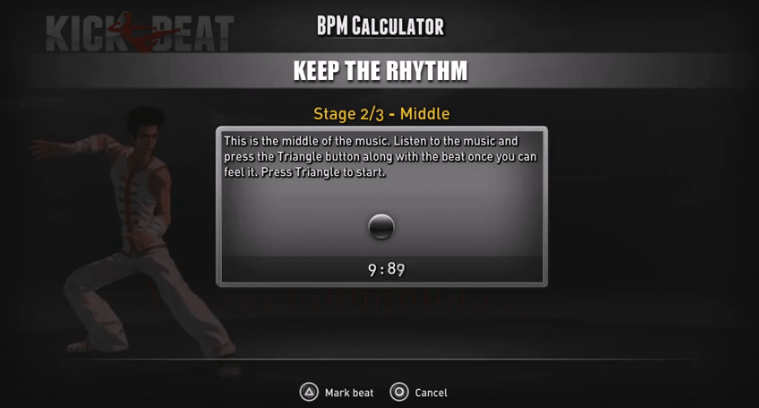
The other main mode allows you to import your own songs to fight to which is a really nice feature and ensures the game isn’t limited to it’s own soundtrack. To create a song you simply have to tap the triangle button to the beat to help the game establish the Beats Per Minute and offset. You can also enter the values in yourself if you know them. I did have a few random glitches in this mode. One song I tried to use seemed to work fine when creating it, but upon playing the song in game the music never played. Another time I was marking the beat of a song and the end section was of a completely different song. One should also note that while any song can be imported that is longer than 1 minute and shorter than 6, not all music works well with the games generator. Songs with a consistent BPM work best while you will probably have some enemies performing wierdly timed attacks on tracks that change tempo alot such as Skrillex’s Scary Monsters and Nice Sprites. The game does it’s best to get the beat correct and generally does a good job. Unfortunately any accomplishments you make with your own songs won’t allow you to earn stars or even contribute to your total leaderboard score but it’s still a fun mode to try out.
A final note on the gameplay is that the speed of the enemies never really gets faster. I was expecting with an increase in difficulty level I would also see a greater onslaught of enemies and while it felt like enemies were slightly more frequent on harder difficulties, the yellow enemies are generally just replaced by more red and blue enemies. It’s dissapointing because it would of been really awesome to nail a fast sequence of 10 enemies to the beats of the bass drum at the end of a song, but enemies normally only attack on the beat rather than to the individual parts of a song that stand out.
Visuals
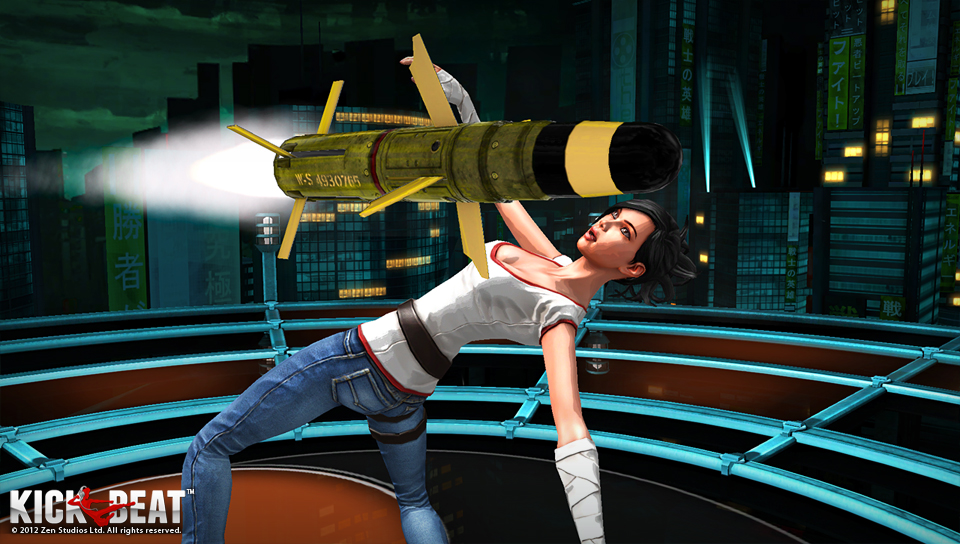
Quite simply the graphics look great. Characters have a nice detailed cel shaded look to them as do enemies and both the main characters and enemies have a number of different outfits they wear to mix things up. The animations the characters perform are also well designed. Watching your main character zip around performing handstand kicks, backflips and double bent over punches is awesome and the slow motion parts that end each section of the song are impressive. It’s pretty cool watching your main character dodge a punch and then retaliate with a kick to the face or jump in the air and kick two enemies at once in midair with a split kick. The six different arenas you fight in are full of life with great lighting effects and background elements such as crowds or pumping speakers. The way the arenas pulse to the beat not only looks cool but helps the player establish the sense of rhythm. The dynamic camera brings a higher sense of impact to the kung fu action and can immerse you even further in the action, but can be turned off in the options menu if you feel it is messing up your combos as sometimes the zooms and camera shakes can be distracting.
While the graphics themselves are great, they do negatively impact on the already troubled visual cues at times. Some of the lighting effects and dark tones of the backgrounds can unfortunately hinder your ability to distinguish between the types of enemies. The enemies wear colour coded clothing but it isn’t overly obvious and is sometimes hard to see against the backdrop of the statge. In the Monastery stage for example, the boss fight features red lighting and a different camera angle than what you are used to, making it hard to see red enemies in particular which means you may mistake them for a yellow enemy, especially if you can only spot one of the red attackers and don’t notice the pair. The club stage can also be rather dark at times, with no light or purple pulsing lights making the blue enemies hard to see. The enemy that is attacking next will have a white glow around them, but this glow can get lost in the background and finding it can be difficult especially when the enemy attack will be coming up in less than half a second. This is the most noticable with the blue enemies as they attack in groups of two or three and once the first one attacks you then have to quickly search for the white glow to make sure you know which of the other two blue enemies in that group will attack you next. The way they move around the circle doesn’t give much further indication as both seem like they are in a plausible position to attack.
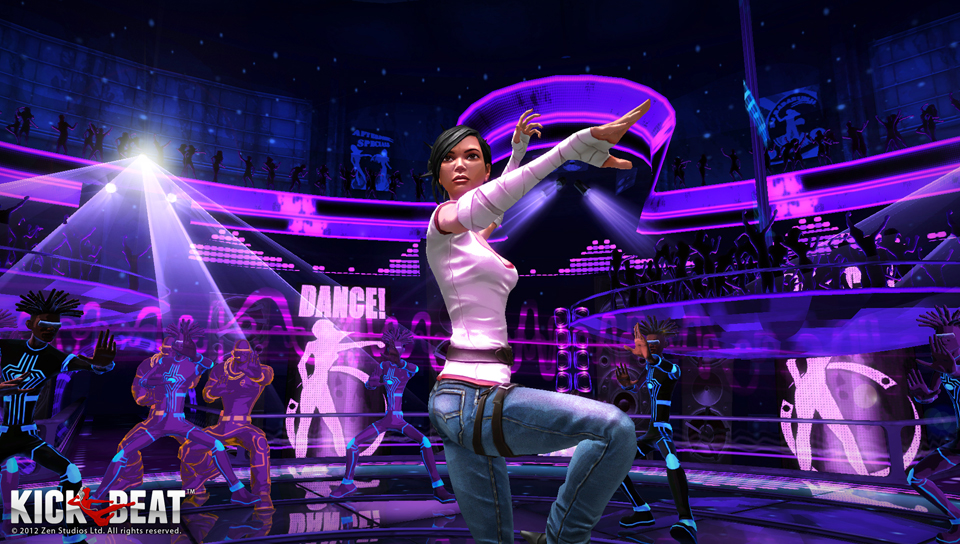
The visual cues also have trouble coming across clearly in terms of their composition, more so when alot of enemies are on screen. The bottom right corner where you press the square button felt most problematic, with some enemies that were getting ready to come into their attack position blocking the view of enemies that attacks were coming up sooner which is because of the way they circle around the center of the stage. The placement of the multiplier could also have been better. Because you have to focus on the enemies at hand you don’t really get time to look at the multiplier which is placed in the top right hand corner of the screen away from your score. While this doesn’t seem like such a big deal, you need to know your current mulitplier to inform your deicison of when to use your chi so you don’t waste it. You won’t have a similar problem identifying your health, chi and remarks on your attack timing as they are placed nicely in the center of the screen and are easy to read.
Audio
A music game can only be as good as its songs and KickBeat doesn’t dissapoint in that department considering it’s status as a cheap downloadable title. The 18 licensed tracks included in the game are all really high energy and fit the game perfectly. I would of liked to see more variety though as nearly the entirely tracklist is made of songs consisting of a heavy rock influence with a few rap songs. Dubstep and techno music seem like an awesome fit for this game, but The Construct by The Voicians is the closest you get to those genres and was my favourite song in the game which left me craving similar sounds other than rock. Tracks are constructed well with the beats and enemy attack patterns matching perfectly most of the time but there a rare couple of instances where hitting the enemies on their attacks felt a bit off, I noticed this particularly in the first half of Papa Roach’s Last Resort.
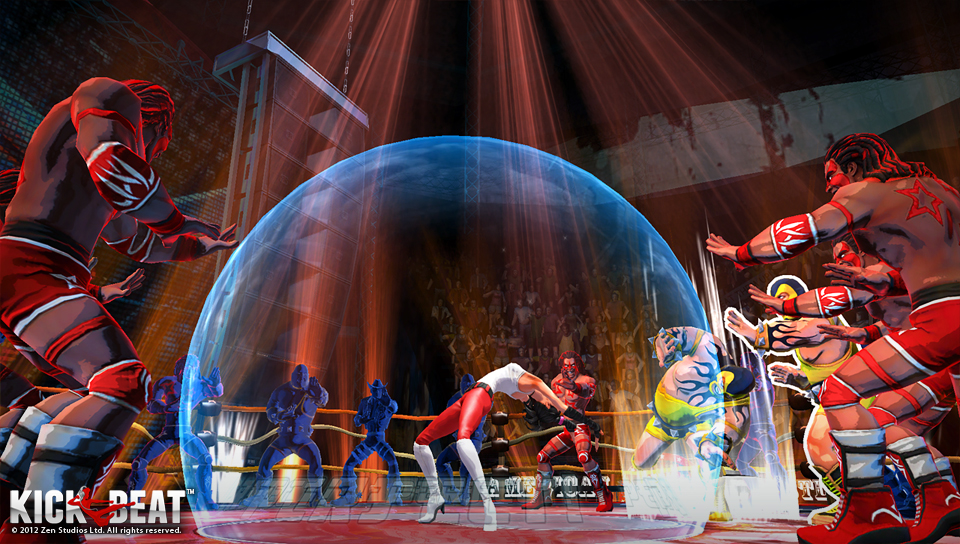
Standard kung fu impact sounds are heard while fighting your enemies and it’s satisfying to land your blows in tune with the music. I mentioned the unique animations that occur in the visuals part of this review and these look very satisfying, but they strangely lack any sound which largely takes away from the impact. Would of been great to hear some bones cracking or the enemy groaning or even your character making some sort of yell. Voice acting also seems to be missing from any in game cutscenes which seems wierd especially when the rest of the story has voice overs.
Overall
With its low price and high replay value, Kickbeat definitely gives the player alot of value for money. When you’re hitting all the right notes like a kung fu master and taking out enemies to the beat of the well picked high energy soundtrack or song from your own personal collection, then it’s one of those top gaming experiences where you just feel immersed in the game and are having an excellent time. Unfortunately, the difficulty in achieving that sensation due to the sometimes hard to read visual cues weighs down the experience and is hard to excuse in a genre where knowing what notes you have to hit and when is so integral. Some technical problems and a couple of offbeat sections also stop you from achieving what can be a great experience. KickBeat has definite room for improvement in a number of areas, but is a decent effort by Zen Studios, especially when considering the innovation they are introducing to the rhythm game genre.


